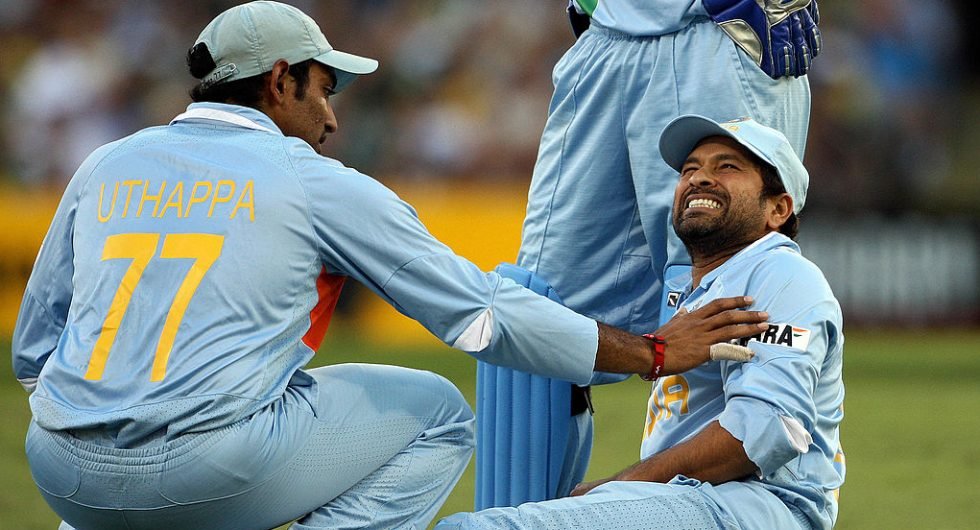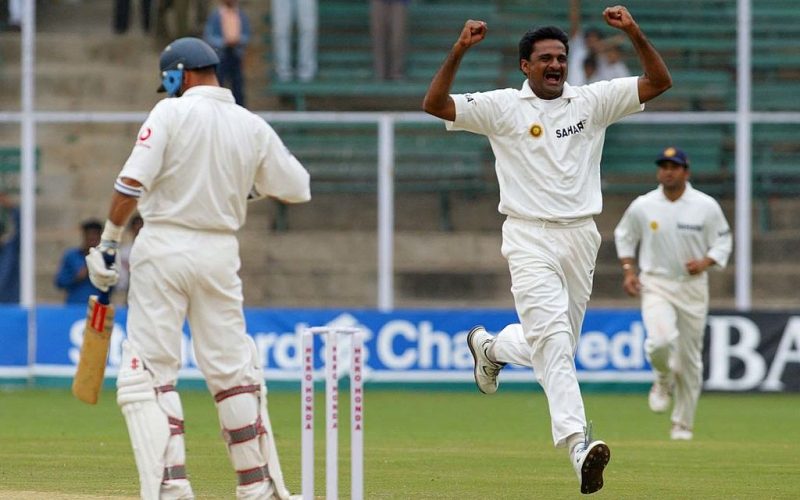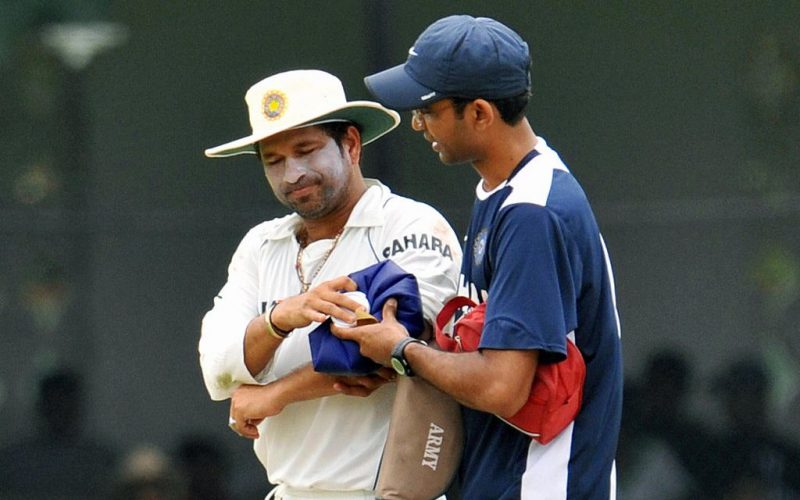Indian cricket, and the ‘rotating cup’ syndrome – Wisden India Almanack

Bharat Sundaresan on the ‘rotating cup’ syndrome, and how Indians had a strange connection with Sachin Tendulkar’s anatomy.
“Rotating cup da, rotating cup. It’s apparently one of those injuries that’s common with your cricketeers (Tamil for cricketers),” my aunt screamed from her emergency ward bed of the orthopaedic hospital she’d found herself in. Earlier that day, she’d slipped and fallen on the footpath outside her home. Attempts at breaking the fall with her palm had done severe damage to her right shoulder. And the doctor’s prognosis, in her words anyway, didn’t sound like any bodily issue I’d ever heard a cricketeer suffer from. It sounded more like a kitchen experiment gone wrong. Eventually it took my cousin to clear the air as he announced, “My amma suddenly just found something she shares in common with both Javagal Srinath and Sachin Tendulkar. She’s torn her rotator cuff.”
Srinath, after all, was the first Indian cricketer of the modern era to introduce us to this vital part of the shoulder made up of muscles and tendons that assist in all kinds of upper-torso motion, not just in bowling fast. This anatomical enlightenment happened in early 1997 when India’s then pace spearhead broke down following a hectic and extended stint on the road. He’d bowled over 400 overs during the previous year across Test matches in England, South Africa and at home. The breakdown was inevitable. Srinath was India’s only genuine fast bowler in that era. It was a big deal that he was gone for nearly nine months. So much so that a national daily even carried a spoof story on April 1 of that year claiming that the “Mysore Express” was planning a return to the team as a left-arm spinner.

Javagal Shrinath was India’s premier fast bowler during the nineties and early 2000s
But the rotator cuff and shoulder injuries remained “fast bowler” problems and therefore rather alien, not something that would worry Indian cricket too often, till Sachin Tendulkar came under the knife in 2006 for a shoulder surgery. It wasn’t the exact same issue though.
Like it had been the case and would continue to be so till the end of his career, a Tendulkar injury ended up burgeoning India’s medical vocabulary. And by then, the ‘tennis elbow’ had already become the all-time most popular sports injury in India. ‘SLAP lesion’ was only the latest entry into the book. It was basically a muscle tear caused by excessive use, a throwing injury more than a batting or bowling one. After battling with it for a few months, Tendulkar was finally forced to go for surgery, missing five months of cricket in the process.
India always had a strange connection with the Tendulkar anatomy ever since he made his debut and got struck on the face by Waqar Younis as a 16-year-old baby-faced prodigy, whom everyone in the nation wanted to mother. For all the pages he filled up in the record books over 24 years, Tendulkar’s career could easily be converted into a medical journal, the time he spent with physios, trainers and doctors.
“Somebody once told me I could write a book on medicine,” Tendulkar would say while launching his autobiography a few years ago.
There was hardly a part of his body that didn’t give Indian cricket fans heartache at some point or the other during his career. If it wasn’t his back, which was a recurring issue and famously flared up during that 1999 Test against Pakistan in Chennai, it was his toes, his fingers, his ankle, his knee, his hamstring, his neck or his abdomen.
He wasn’t feeling the pain alone though. His pain somehow became every Indian’s pain.

Tendulkar walks back to the pavilion nursing an arm injury during the third Test against Sri Lanka in 2008
None of his injuries caught on like the dreaded tennis elbow. It was perhaps the closest Tendulkar came to losing his aura as he struggled to cope with the debilitating injury. It harangued him for nearly two years and forced him to seek Dr Andrew Wallace’s help, which led to surgery. Wallace would have Tendulkar in his operation theatre a year later for the aforementioned shoulder issue. While wild theories abound over the cause of this injury — from him having used a heavy bat all his life to this being a karmic conspiracy — every Indian had some definitive knowledge of its effects. Understandably, a lot of them started relating to the tennis elbow issue as well. It didn’t seem to matter if they hadn’t spent three quarters of their life holding a bat and scoring a multitude of runs or if all they’d ever used their hands to carry were a few utensils at home or a briefcase to work.
There was suddenly a surge in tennis elbow diagnoses, and the demographics of those suffering with the problem ranged from housewives to medical representatives to the nocturnal kinds on a heavy liquid diet.
The tennis elbow has remained in vogue ever since, even as Tendulkar recovered and played for another half-a-dozen years. I know of at least three members in my wife’s family, all teachers, who have been diagnosed with the problem as recently as last year. Just saying.
The fast bowling revolution in India kind of coincided with the rapid increase in people taking to running as their primary exercise across the country. It came about in the wake of the many high-profile marathons that propped up in all the major cities. Soon enough, the likes of Zaheer Khan, Ashish Nehra and Munaf Patel would break down with injuries to various parts of their legs. And soon enough, there was a sudden rise in household sports injuries around India, particularly to the lower part of the body. People have been pulling up ever since with bad ‘hammies’ or the odd ‘adductor muscle strain’ (the groin) from Cubbon Park to Marine Drive. Even the rotator cuff made a return to the mainstream as Zaheer and Munaf suffered and recovered to win India the 2011 World Cup.
It’s not of course only in India where cricketers’ injuries and in lieu their bodies become topics of national discourse. Michael Clarke’s hamstring was discussed as intensely as craft beer and weather forecasts all across Australia in the lead-up to the 2015 World Cup. As was Shane Warne’s shoulder in the lead-up to the 1998-99 Ashes, Andrew Flintoff’s knees and ankles through his career and every time Shane Watson walked on to a cricket field.
There have been a few bizarre health issues that didn’t quite catch on in everyday use or create much of a stir despite them having inflicted two cricketers of superstar reputation. Harbhajan Singh’s groin infection that made him miss a Test in South Africa and Shoaib Akhtar’s genital warts that ruled him out of the 2009 World T20, which Pakistan incidentally won, are two examples. For that matter, even Lakshmipathy Balaji’s osteitis pubis injury — which put him out for many months — where there’s pain and inflammation in the pelvic region, didn’t get much attention, maybe because it was just too darn difficult to pronounce.
The days of a multi-billion population fretting over one man’s body and its vagaries might be over. Somehow despite Virat Kohli’s omnipresence as a cricketing megastar in India, neither he nor anyone else will ever come close to the kind of national importance that used to be attached to Tendulkar’s fitness. Kohli’s neck injury in the lead-up to what was supposed to be his maiden county stint was on the front-pages with one tabloid even managing to get a sneak peek into the hospital reports and claiming it was a ‘slipped disc’ — which for good reason wasn’t the case considering how staid and non-exotic it sounds.
Cricket will continue to remain a source of medical lessons in India, though, especially with fewer rest days and the amount the players play only burgeoning. Rest assured you haven’t heard the last of rotator cuffs, or rotating cups.
Bharat Sunderesan’s book The Dhoni Touch was released in 2018. He covers cricket for Cricbuzz, after a long stint at The Indian Express.
This essay was first published in the Wisden India Almanack 2019 & 2020.

